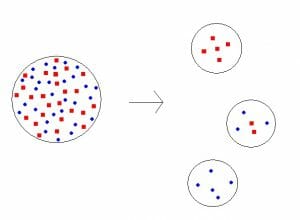Founder Effect Definition
The founder effect is a phenomena that occurs when a small group of individuals becomes isolated from a larger population. Regardless of what the original population looked like, the new population will resemble only the individuals that founded the smaller, distinct population. The founder effect is due to the randomness that accompanies selecting a small group from a larger population. The smaller the population, the higher the chance that the small population does not represent the larger population. See the graphic below. If the few organisms that migrate or get separated from the parent population do not carry the same frequency of alleles as the main population, the resulting founder effect will cause the population that separated to become genetically distinct from the original population. This may lead to a new subspecies of organisms, or even entirely new species given enough time.
The founder effect can take place due to many different circumstances. The founder effect can be due to geographic isolation, when a small population of individuals migrates to a new area. In this case, the distance or obstacles between the two populations make interbreeding impossible, and the new populations become genetically distinct over time. In another scenario, a mutation may cause a population of organisms to become reproductively isolated from the parent foundation. Without the ability to interbreed with the larger population, the small population becomes distinct. If successful it will grow into a new species. Mutations and random allele changes in small populations are collectively known as genetic drift, and the founder effect is a piece of genetic drift.
Examples of the Founder Effect
Genetic Diseases in Humans
Many genetic diseases are increased in prevalence in human population due in part to the founder effect. Small populations of humans are either forcibly separated, or leave the larger genetic pool by choice. An example of the founder effect in this context is the higher incidence of fumarase deficiency in a population of members of a fundamentalist church. Practices of the church included endogamy, or marrying within the religion, and polygyny or the practice of taking several wives. What the founders of the religion did not know was that they carried a severely detrimental allele. The allele created a form of fumarase that was not function. This enzyme is needed to produce energy in the mitochondria. Without functional mitochondria, nearly all the cells in the body are affected. Children that receive a non-functional allele from both parents are severely disabled, with both developmental abnormalities and mental retardation. The founder effect has caused the population that practices this religion to experience a much higher incidence of this specific genetic condition.
Small Islands
Ecologists have been studying small islands for a long time, as the populations between small islands often display remarkable diversity. The Galapagos finches, for example, represent several species of finch that all resemble a mainland finch, with various modifications. The theory remains that the population on the islands is under the influence of the founder effect. It is hypothesized that small colonies of finches were established on each island when storms would carry them far away from the coastline. Due to the small number of finches that arrived at each island, each population only had certain alleles from the parent population. Over time, the populations varied greatly, both in their size and the roles they filled within the ecosystem. Similar examples have been noted in amphibians, reptiles, and mammals. The founder effect is a well-known cause of differentiation between populations that span a great distance. This is known as the serial founder effect, if the individual populations spread over a geographic distance do not interbreed.
Related Biology Terms
- Genetic Drift – Changes in allele frequency not related to natural selection, usually caused by small numbers.
- Population Bottleneck – When a population is limited to a small size by natural selection, many of the genes lost are due to chance, and the alleles left in the population are not necessarily the most adaptive.
- Allele Frequency – The number of a specific type of allele in a population, divided by the total number of alleles.
- Adaptive Radiation – An evolutionarily rapid change between populations, sometimes due to the founder effect over a great distance or series of geographic islands.
Quiz
1. A population of red and blue flowers grows in a greenhouse. A gardener is shopping for new flowers to add to the garden and picks two red flowers. The red flowers are transplanted to her garden. After a few seasons, the flowers have spread their seeds and occupy a large portion of the garden. They are all red. What is this an example of?
A. Genetic Drift
B. Population Bottleneck
C. Founder Effect
D. A and C
E. All of the above
2. The founder effect is seen in a population of dandelions (aka blowball or puffball flowers) that exist next to a river. The wind carries the seeds of all dandelions, but only a very small percentage make it to the other side. The flowers in the established population are yellow and white. What color(s) will exist in the founder population?
A. Yellow
B. White
C. Both
D. Either or both, randomly
3. A large population of rabbits exists on an island. An adjacent island has no rabbits. As an experiment, scientists divide the rabbits in half, each with the same frequency of alleles. One group is placed on the uninhabited island and both groups are watched. Is this an example of the founder effect?
A. Yes, but only if the groups evolve differently
B. No, the founders are the same as the parent population
C. Yes, because the rabbits are founding a population on a new island.

